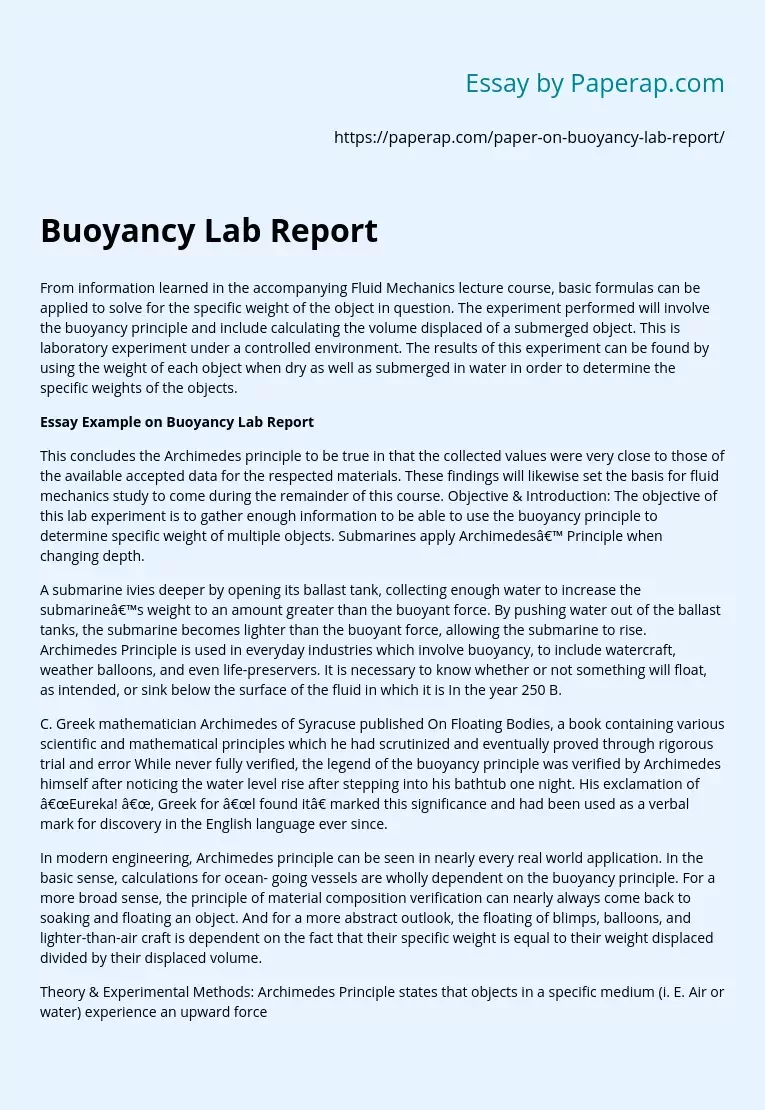Fluid Mechanics Buoyancy Lab Report
From information learned in the accompanying Fluid Mechanics lecture course, basic formulas can be applied to solve for the specific weight of the object in question. The experiment performed will involve the buoyancy principle and include calculating the volume displaced of a submerged object. This is laboratory experiment under a controlled environment. The results of this experiment can be found by using the weight of each object when dry as well as submerged in water in order to determine the specific weights of the objects.
Archimedes Principle and Buoyancy
This concludes the Archimedes principle to be true in that the collected values were very close to those of the available accepted data for the respected materials. These findings will likewise set the basis for fluid mechanics study to come during the remainder of this course. Objective & Introduction: The objective of this lab experiment is to gather enough information to be able to use the buoyancy principle to determine specific weight of multiple objects.
Submarines apply Archimedes’ Principle when changing depth.
A submarine ivies deeper by opening its ballast tank, collecting enough water to increase the submarine’s weight to an amount greater than the buoyant force. By pushing water out of the ballast tanks, the submarine becomes lighter than the buoyant force, allowing the submarine to rise. Archimedes Principle is used in everyday industries which involve buoyancy, to include watercraft, weather balloons, and even life-preservers. It is necessary to know whether or not something will float, as intended, or sink below the surface of the fluid in which it is In the year 250 B.
C. Greek mathematician Archimedes of Syracuse published On Floating Bodies, a book containing various scientific and mathematical principles which he had scrutinized and eventually proved through rigorous trial and error While never fully verified, the legend of the buoyancy principle was verified by Archimedes himself after noticing the water level rise after stepping into his bathtub one night. His exclamation of “Eureka! “, Greek for “l found it” marked this significance and had been used as a verbal mark for discovery in the English language ever since.
In modern engineering, Archimedes principle can be seen in nearly every real world application. In the basic sense, calculations for ocean- going vessels are wholly dependent on the buoyancy principle. For a more broad sense, the principle of material composition verification can nearly always come back to soaking and floating an object. And for a more abstract outlook, the floating of blimps, balloons, and lighter-than-air craft is dependent on the fact that their specific weight is equal to their weight displaced divided by their displaced volume.
Theory & Experimental Methods: Archimedes Principle states that objects in a specific medium (i. E. Air or water) experience an upward force known as buoyant force. In order for something to stay afloat, this force must be equal in magnitude or in the case of lift with a hot-air balloon, greater than, the weight of the volume displaced by that object. Moreover, this amount of substance or in the case of this experiment; the water (or fluid) displaced will be equal to the volume of water displaced divided by the specific weight of the object.
Fluid Mechanics Buoyancy Lab Report. (2019, Nov 27). Retrieved from https://paperap.com/paper-on-buoyancy-lab-report/

